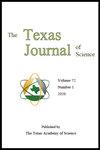水蚁属的触角形态(半翅目:水蚁科)
Q4 Agricultural and Biological Sciences
引用次数: 0
摘要
触角感受器是首次记录在海螺科。Hydrorephes sp.中的感器包括三种形式的毛状感器和两种形式的叶状感器。大部分感觉器位于远端节段的顶端三分之二。海螺科触角的形态似乎对定义属具有分类学意义,它可能有助于确定海螺科内各属之间以及海螺科和Pleidae科之间的关系。本文章由计算机程序翻译,如有差异,请以英文原文为准。
THE ANTENNAL MORPHOLOGY IN THE GENUS HYDROTREPHES (HEMIPTERA: HELOTREPHIDAE)
Antennal sensilla are documented for the first time in the family Helotrephidae. Sensilla in Hydrotrephes sp. include three forms of trichoid sensilla and two forms of leaf-like sensilla. Most of the sensilla are located on the apical two thirds of the distal segment. Morphology of the antenna in Helotrephidae appears to be of taxonomic use to define genera and it may be useful to determine relationships between genera within Helotrephidae and between the families Helotrephidae and Pleidae.
求助全文
通过发布文献求助,成功后即可免费获取论文全文。
去求助
来源期刊

The Texas Journal of Science
Agricultural and Biological Sciences-Ecology, Evolution, Behavior and Systematics
CiteScore
0.50
自引率
0.00%
发文量
2
期刊介绍:
Scholarly manuscripts reporting original research results in any field of science or technology, including science education, will be considered for publication in The Texas Journal of Science. Prior to acceptance, each manuscript will be reviewed by both knowledgeable peers and the editorial staff. Authors are encouraged to suggest the names and addresses of two potential reviewers to the Manuscript Editor at the time of submission of their manuscript.
 求助内容:
求助内容: 应助结果提醒方式:
应助结果提醒方式:


